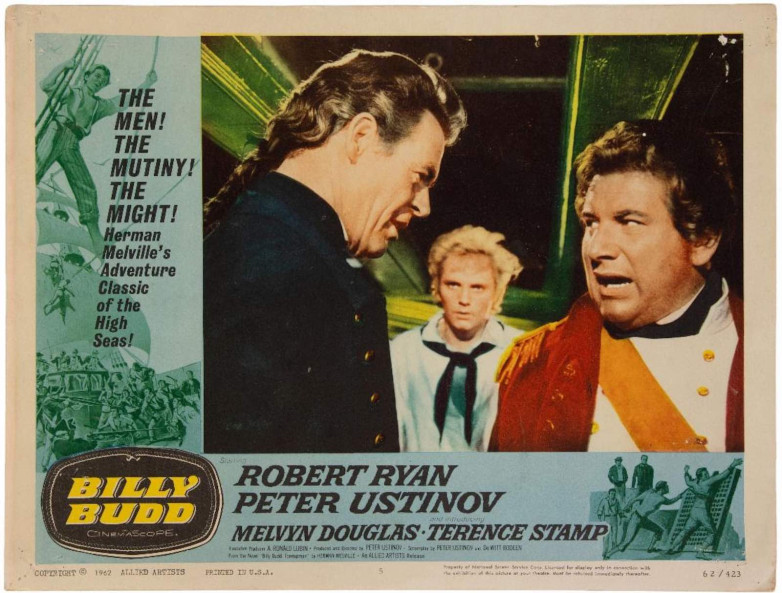Grolier Club Celebrates Herman Melville’s Billy Budd at 100

The 1962 Allied Artists’ film production of Billy Budd, starring Robert Ryan, Peter Ustinov and Terence Stamp as Billy
On view in the Grolier Club’s second floor gallery from September 12 through November 9, Melville’s Billy Budd at 100 highlights the work left unfinished on Melville’s desk at his death in 1891 and posthumously published in 1924.
The exhibition is curated by Grolier Club member William Palmer Johnston from his extensive Melville collection and features more than 50 items including multiple scholarly editions of the Billy Budd manuscript, illustrations, photographs, dust jackets, movie posters, an opera libretto, playbills, a commemorative stamp, unique fine bindings for limited editions, and original artwork by Barry Moser and Duke Riley.
"The exhibition highlights the progression of the composition, preservation, ‘discovery,’ and ongoing transmission of Melville’s Billy Budd, a singular work of art,” he said. “The challenging nature of Melville’s unfinished narrative compels us to join in the ongoing struggle to make sense out of the ambiguities and to find meaning in a world of fog and paradox.”
Melville’s Billy Budd at 100 traces the century-long journey of the published novella, from editorial print and digital transcriptions of the unfinished manuscript leaves, to studies in book history, biography, textual scholarship, and critical interpretations, as well as artistic adaptations for illustrated editions, theater, opera, and film.
On view are scholarly editions of the manuscript in five publications, beginning with the 1924 Constable first edition, titled Billy Budd, Foretopman. What Befell Him in the Year of the Great Mutiny, Etc., a title Melville is now known to have discarded. Most recent is the 2019 Melville Electronic Library online “fluid text” edition, compiled through a nine-year scholarly analysis of the original manuscript leaves and Melville’s myriad revisions to explore the author’s creative process.
Many editions of the Billy Budd books on view have dust jackets illustrated with maritime imagery and ropes that foreshadow Billy’s fate, such as the curving ropes on the cover of the 1946 John Lehman edition, and a dark noose hanging over a ship on the 1962 University of Chicago Press Phoenix paperback edition. Visitors can compare artist Duke Riley’s scrimshaw-inspired original study drawing for the cover of the 2016 Penguin Classics edition to the final book design, in which Riley added a noose in the foreground, replaced a rat with a dove, and added a starry heavenly backdrop.
Poetry was Melville’s primary literary focus in the last decades of his life and the novella concludes with the poem Billy in the Darbies. Also on view in the exhibition are the signed typescript of W. H. Auden’s 1939 poem Herman Melville as well as a broadside of the poem with artist Barry Moser’s illustrations of a condemned Billy with the shadow of a noose and of a sinking shroud.
The exhibition also features publicity posters from the 1962 Allied Artists’ film production of Billy Budd, starring Robert Ryan, Peter Ustinov and Terence Stamp as Billy in his screen debut, as well as the U.S. postage stamp portrait of Herman Melville, issued in 1984 as part of the USPS Literary Arts Series, with an envelope including a scene from Billy Budd.
Following the Grolier Club, the exhibition will travel to Oberlin College Libraries in Ohio from November 17 through December 20.
















